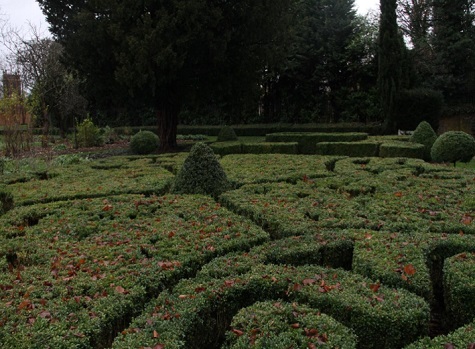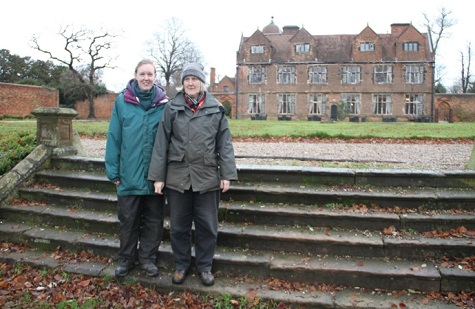As a practicing horticulturalist, I gained a lot of my knowledge and experience from visiting long established formal gardens and seeing at first hand the wonderful array of plant species we have managed and maintained over the last two hundred years.

During my early career I was fortunate to have had the chance to work as a parks apprentice and propagator for Birmingham Parks Department, working in some premier parks, such as Kings Heath and Cannon Hill Park. Happy days they were too.
We in this country are spoiled with the vast array of established gardens we can visit. Traditionally many were founded by the popularity of the Victorians, who in the early 1900s began establishing the many formal parks and gardens we are able to enjoy today.
However, much of this plant knowledge and enthusiasm for plant collections began much earlier with many dating back to the Elizabethan times. One such garden I recently visited is the little known, Castle Bromich Hall Gardens a small gem of a find in the middle of the urban sprawl of Birmingham.

Castle Bromwich Hall Gardens are an important example of English Formal Garden design. Being 10 acres in total, 8 acres within the walls and 2 acres of outer garden now restored to how they were when completed in approximately 1740, makes them a unique item of British heritage. Many formal gardens were swept away from early in the 18th century when the English Landscape (‘romantic’) style of garden layout became fashionable.
Later in the 18th century this style was popularised by Lancelot (‘Capability’) Brown. Castle Bromwich’s Gardens are certainly one of the largest of these walled Gardens remaining in the United Kingdom and with their terraces and surrounding walls, they were created by some of the most outstanding artists, craftsmen and designers of that time. They make an important contribution to our cultural heritage and garden history. However, the passage of time and extensive vandalism reduced them to a shadow of what they once were.
Following a report in 1982, Castle Bromwich Hall Gardens Trust was established in 1985 with one of its objectives being to restore them to their state in the mid 18th century. (As vividly portrayed in Henry Beighton’s Prospect (1726) and published in William Dugdale's "Antiquities of Warwickshire" 1730).
Originally laid out in the 17th and 18th centuries, the formal design has survived until today. The trust has restored the gardens to the appearance of 1740-1760 when the Bridgeman family, the Earls of Bradford occupied the hall. The family moved to Weston Park in 1762 and rented out the hall. Countess Ida reoccupied it in 1869 keeping the layout intact. She died in 1936 and the hall was then used by various commercial interests with the gardens falling into disrepair.

Following the initial restoration the Trust are now in the process of reassessing the layout of the structural plants. They have recently completed some bulb planting to enhance the gardens spring display.
The Trust now employs a small team of key people who between them manage, run and promote the gardens trying to attract as many visitors as possible.
- Ann Brookman - Education Officer has been in post since January 2010. She started working with community groups as part of the Neighbourhood Agenda 21 Scheme for a local authority. Some of this involved environmental improvement schemes and work with Friends groups. At the same time she was volunteering with the National Trust and developed an interest in garden history. Her current post combines her love of horticulture and history with the opportunity of sharing it with visitors and school groups.
- Denise Seckham - Lead Gardener has been in post since February 2018. Always a keen gardener, especially after a chance encounter with Alan Titchmarsh. After attending several horticultural courses at Pershore College, she soon found a job working at the Birmingham Botanical Gardens, followed by a stint of 8 years at Stowe a National trust Property.
- Glynis Powell - General manager has been in post since March 2015. An Art Historian by education she has spent the last 30 years, firstly in media, tv and community training and then in advising museums and heritage sites across everything from audience development, through fundraising to social media marketing.
- Tanya Upton - Gardener. Tanya has worked at Castle Bromwich Hall Gardens for nearly a year, after doing a WRAGS placement for one year and previously volunteering at the gardens in her spare time. After completing her RHS Level 2 qualification, she now studying towards the RHS Level 3 qualification.
Between them they have a keen interest to continue the development and enhancement of the gardens. In total there are five paid staff (General Manager, Office and Volunteer Manager, Part-time Education Officer, Full time Gardener, Gardener (4 days) plus 1 Wrags Placement Gardener (funded for 2 days).
As for machinery and equipment they have the essential tools such as a ride on lawnmower, strimmer, hedge trimmers, rotary self-propelled lawnmower, hover mower, rotavator and compact tractor to keep the gardens maintained.

After a brief introduction to all the staff, I was duly shown around the gardens by Ann and Tanya who described the work here at the gardens as always varied, with a range of planting situations, from the herbaceous borders, lawns, wildernesses, vegetable garden, orchards, and wildlife areas.
“There is always a lot of weeds to keep on top of, and we try to hand-weed and use woodchip mulches where possible in the large wilderness beds,” said Ann. “The lawns and grass paths are mown weekly during the high growing season (May-September) and fortnightly in spring and autumn.
“We use the ride-on mower with a mulching deck for the larger areas of grass such as the Archery Lawn and outer orchard. In the outer orchard, which is outside of the main walled garden, it is a bit less formal and we allow areas of grass to grow long in the summer for the benefit of wildlife, cutting ribbons of grass short into informal paths to allow people to walk around. After the wildflowers have set seed and at the end of the summer season we mow the whole lot back for the winter.

“For the paths and smaller areas we use the petrol pedestrian mowers with rear roller. For the large paddocks in the car parking area we have a tractor with a mower attachment to use over the summer and before events when the extra car parking space is needed.”
As there are so many grass paths in the gardens there is a lot of edging to be done, which is done with hand edging shears to keep a crisp finish and line. “In autumn,” explained Ann, “we collect some leaves to create leaf-mould, but also mow over some areas and let nature break the resulting small bits down further.
“We have had a problem with chafer grubs this year on the Archery Lawn, and resulting damage from the crows and magpies pulling the grass up to feed on them. We are currently trying to renovate the affected areas by removing the damaged grass and raking the ground over. In spring we will try and reseed it, and if unsuccessful and funds allow, we may re-turf it.”
As for visitors the gardens get in the region of 10,000 per year - made up of a variety of users: casual visitors, schools and family groups and event visitors. With the main restoration work completed, it is now a case of improving the visitor experience and ensuring the sustainability of the gardens.
So next time you want to see something different and get a feel how the Elizabethans lived and enjoyed their gardens, take the opportunity to visit these wonderful gardens.